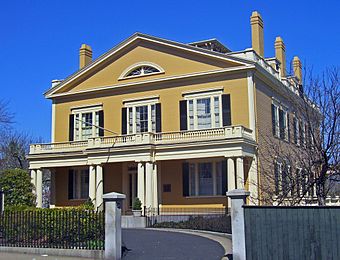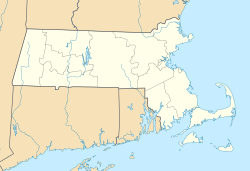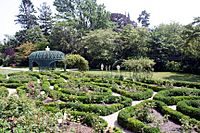Rotch–Jones–Duff House and Garden Museum facts for kids
|
William Rotch Jr. House
|
|
|
U.S. Historic district
Contributing property |
|

Front (west) elevation, 2008
|
|
| Location | 396 County Street, New Bedford, MA |
|---|---|
| Area | 1 acre (4,000 m²) |
| Built | 1834 |
| Architect | Richard Upjohn |
| Architectural style | Greek Revival |
| Part of | County Street Historic District (ID76000229) |
| NRHP reference No. | 05000456 |
Quick facts for kids Significant dates |
|
| Added to NRHP | April 5, 2005 |
| Designated NHL | April 5, 2005 |
| Designated CP | August 11, 1976 |
The Rotch–Jones–Duff House and Garden Museum is a special historic place in New Bedford, Massachusetts. It used to be called the William Rotch Jr. House. This house is a National Historic Landmark, which means it's very important to the history of the United States. It's located at 396 County Street.
The three families who lived here – the Rotches, Joneses, and Duffs – were all connected to New Bedford's big whaling industry in the 1800s. Because of this, the house is now part of the New Bedford Whaling National Historical Park.
A famous architect named Richard Upjohn designed the house in 1834 for William Rotch Jr. It was built in the Greek Revival style, which was popular back then. This was one of Upjohn's first houses. William Rotch Jr. also started a garden behind the house, which later owners made much bigger and more beautiful.
The house was a private home until 1981. Then, people who wanted to save old buildings bought it. They turned it into a historic house museum. In 2005, it was officially named a National Historic Landmark. Today, the museum teaches visitors about whaling history. It also uses its gardens and special programs for schools to teach about nature and the environment.
Contents
The Historic Property
The house sits on a one-acre piece of land in New Bedford. It's located between County, Madison, Joli Gonsalves, and Seventh streets. This area is part of the County Street Historic District, where many wealthy people built their large homes in the 1800s.
The house is a two-story yellow building. It has a front porch and balconies with railings on each end. Several tall chimneys rise from the roof. Inside, you can still see many of the original doors made of mahogany wood with walnut wood designs. The house has beautiful details like carved plaster ceilings.
A round driveway leads up to the house. The house is set back about 40 feet (12 meters) from the street. This allows space for other small buildings and the property's large garden. The garden shows parts from all three families who owned the house. It has a formal boxwood rose garden, a special boxwood garden, a cutting garden, and a Woodland Walk. There's also a wooden latticework pergola from the 1800s.
A Look at History
Early Whaling Days
William Rotch Jr.'s grandfather, Joseph Rotch, was one of the first people to settle in New Bedford in the 1760s. He and another landowner, Joseph Russell, realized that New Bedford was a great place to become a whaling center. They thought it could even become bigger than Nantucket, which was the main whaling town at the time. New Bedford had a deep harbor where large ships could easily come to port and unload their whale oil and other goods.
Even with some challenges during the American Revolution and the War of 1812, New Bedford's whaling fleet kept growing. By the late 1820s, it was catching up to Nantucket's fleet. Ship captains and owners became very rich. They built grand homes in the County Street area. The famous writer Herman Melville wrote in his book Moby-Dick that New Bedford had "more patrician-like houses; parks and gardens more opulent" than anywhere else in America. The Rotch family was involved in every part of the whaling business, which made them very wealthy.
Building the House
William Rotch, William Jr.'s father, passed away in 1828. He left the land where the house now stands to his son, William Jr. Three years later, William Jr. officially received the land. He was already a respected leader in New Bedford. He had helped start banks and schools.
William Jr. hired a young English architect named Richard Upjohn to design his new house. William Jr. wanted his house to be simpler than his neighbors' homes, even though he was one of the richest men in the city. He was also a founder of the New Bedford Horticultural Society, and he started the special garden behind the house.
Later Owners and the Museum
By 1851, New Bedford had become the biggest whaling center in America. In that year, Edward Coffin Jones bought the house for $17,000. He was from Nantucket but had moved to New Bedford and became a successful ship owner. The Jones family made the garden even bigger, adding the pergola.
One of Edward's daughters, Amelia Hickling Jones, lived in the house for 85 years. She was a generous person who helped the city a lot as it changed from whaling to making textiles. When she passed away in 1935, the house was put up for sale because she had no children.
Mark Duff, whose family was also involved in New Bedford's whaling history, bought the house in 1936. The Duff family redecorated the house and added many new plants to the garden, including 7,000 tulip bulbs. They also added walkways and decorative ponds.
In 1981, the Duff family decided to sell the house. The Waterfront Historic Area LeaguE (WHALE) bought it. WHALE is a local group that works to save historic buildings. They had helped restore and protect the nearby New Bedford Historic District. WHALE wanted to save the house from being used for businesses and turn it into a museum. The museum opened in 1983.
In 1996, the house became the only property outside the New Bedford Historic District to be part of the New Bedford Whaling National Historical Park. Then, in 2005, the house and garden were named a National Historic Landmark. This was because it showed New Bedford's important whaling history, was a great example of a Greek Revival house, and was one of the first houses designed by Richard Upjohn.
Visiting the Museum
The Rotch–Jones–Duff House and Garden Museum is open every day except for major holidays. There is an admission fee, but it's free on the second Thursday evening of every month (except January).
The museum offers several educational programs. Students in grades 4-6 can learn about botany (plants), beekeeping, and whaling using the house and gardens. Teachers can find helpful materials online. Older students in high school and college can even work as interns. The beautiful grounds and gardens can also be rented for special events like weddings or photos.
See also




